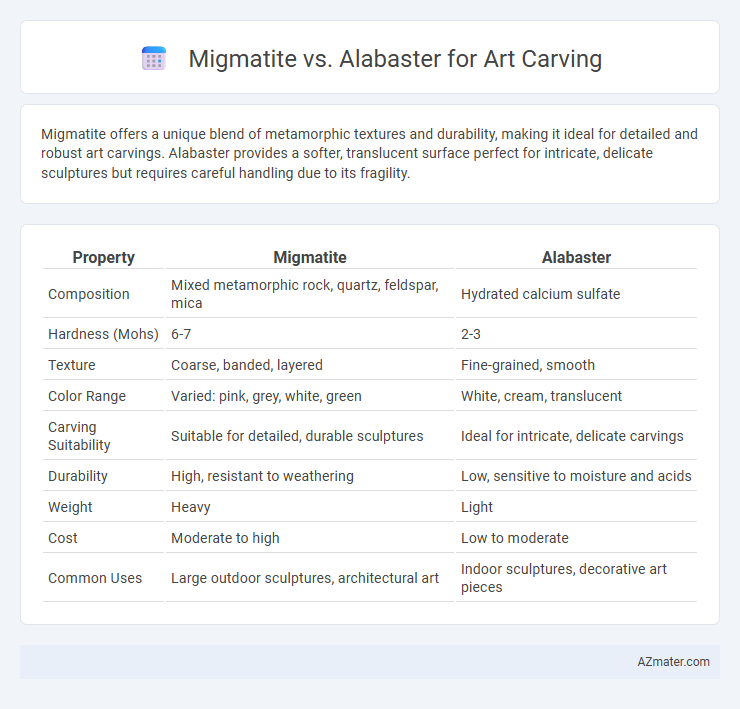Migmatite offers a unique blend of metamorphic textures and durability, making it ideal for detailed and robust art carvings. Alabaster provides a softer, translucent surface perfect for intricate, delicate sculptures but requires careful handling due to its fragility.
Table of Comparison
| Property | Migmatite | Alabaster |
|---|---|---|
| Composition | Mixed metamorphic rock, quartz, feldspar, mica | Hydrated calcium sulfate |
| Hardness (Mohs) | 6-7 | 2-3 |
| Texture | Coarse, banded, layered | Fine-grained, smooth |
| Color Range | Varied: pink, grey, white, green | White, cream, translucent |
| Carving Suitability | Suitable for detailed, durable sculptures | Ideal for intricate, delicate carvings |
| Durability | High, resistant to weathering | Low, sensitive to moisture and acids |
| Weight | Heavy | Light |
| Cost | Moderate to high | Low to moderate |
| Common Uses | Large outdoor sculptures, architectural art | Indoor sculptures, decorative art pieces |
Introduction to Migmatite and Alabaster
Migmatite is a hybrid rock formed under high-temperature conditions, combining igneous and metamorphic features with a characteristic banded appearance, making it dense and durable for intricate art carving. Alabaster, a fine-grained, soft stone primarily composed of gypsum, is prized for its translucency and ease of carving, allowing artists to create detailed and delicate sculptures. The contrast between migmatite's hardness and alabaster's softness defines their suitability for different styles and techniques in art carving.
Geological Origins and Composition
Migmatite, a complex rock formed through high-grade metamorphism, consists of a mixture of metamorphic and igneous components, primarily quartz, feldspar, and mica, creating a marbled appearance ideal for detailed carvings that demand durability. Alabaster, a fine-grained sedimentary gypsum or calcite, features a softer, translucent surface with a uniform texture valued for intricate, delicate art carvings but less resistant to weathering and mechanical stress. The geological origin of migmatite involves partial melting and recrystallization in deep crustal environments whereas alabaster forms through the evaporation of mineral-rich waters in sedimentary basins, influencing their respective textural and structural properties suitable for different artistic applications.
Visual Characteristics: Color and Texture
Migmatite offers a striking visual appeal with its complex blend of light and dark mineral bands, creating a marbled texture that enhances depth and contrast in art carvings. Alabaster exhibits a smooth, translucent quality with consistently soft white or cream hues, ideal for intricate detailing and a luminous finish. Artists often prefer migmatite for bold, dynamic patterns, while alabaster is favored for delicate, refined sculptures emphasizing subtle color variations.
Workability and Carving Techniques
Migmatite, with its mixed metamorphic and igneous composition, presents challenges in art carving due to its variable hardness and grain size, requiring advanced chiseling and grinding techniques for detailed work. Alabaster is preferred for fine art carving because of its softness, uniform texture, and ease of manipulation using hand tools like rasps and files, making it ideal for intricate designs and smooth finishes. Sculptors favor alabaster for its predictable workability, while migmatite demands experience and specialized tools to handle its uneven structure and layered patterns effectively.
Durability and Weather Resistance
Migmatite exhibits superior durability and weather resistance compared to alabaster, making it ideal for outdoor art carvings exposed to variable climates; its hybrid metamorphic structure combines partially melted rock that enhances strength and resilience. Alabaster, while prized for its smooth texture and translucency, is softer and more susceptible to weathering and acid rain, leading to surface erosion and loss of detail over time. Artists seeking longevity in sculptures intended for exterior display commonly prefer migmatite for its ability to withstand harsh environmental conditions without significant degradation.
Suitable Artistic Applications
Migmatite offers a unique combination of metamorphic textures and durability ideal for intricate art carvings requiring fine detail and structural stability. Alabaster's soft, translucent quality makes it perfect for sculptures emphasizing smooth, delicate features and light interplay. Artists often choose migmatite for bold, textured designs while alabaster is preferred for refined, luminous finishes in art carving.
Cost and Availability
Migmatite is generally more expensive than alabaster due to its rarity and complex formation process, which affects both cost and availability. Alabaster is widely available and more affordable, making it a popular choice for artists focused on budget-friendly materials. The cost efficiency and easier sourcing of alabaster often outweigh migmatite's unique aesthetic appeal for art carving projects.
Historic and Contemporary Use in Sculpture
Migmatite, a metamorphic rock combining igneous and sedimentary features, has been prized historically for its durability and intricate patterns, making it a favored medium in both ancient and contemporary sculpture. Alabaster, a softer, fine-grained gypsum or calcite mineral, has long served sculptors seeking delicate translucency and ease of carving, with its use dating back to ancient Egyptian and Mesopotamian art. Contemporary artists often select migmatite for large, resilient outdoor installations, while alabaster remains dominant in detailed indoor carvings and fine ornamental art due to its smooth texture and light diffusion properties.
Maintenance and Longevity of Artworks
Migmatite offers superior durability and resistance to weathering, making it ideal for long-lasting outdoor art carvings that require minimal maintenance. Alabaster, known for its softness and translucence, is more prone to scratching, chipping, and moisture damage, demanding careful handling and regular sealing to preserve its appearance. For artworks intended to endure over time with reduced upkeep, Migmatite's structural integrity and low porosity provide significant advantages over Alabaster.
Choosing Between Migmatite and Alabaster for Your Project
Migmatite offers exceptional durability and intricate natural patterns ideal for large-scale or outdoor art carvings, whereas alabaster is prized for its softness and translucency, making it perfect for delicate, detailed indoor sculptures. Consider the environmental conditions and desired finish; migmatite withstands weathering and maintains texture over time, while alabaster requires careful handling due to its softness and sensitivity to moisture. Selecting between migmatite and alabaster depends on balancing artistic detail needs with the physical resilience required for your specific art carving project.

Infographic: Migmatite vs Alabaster for Art Carving
 azmater.com
azmater.com